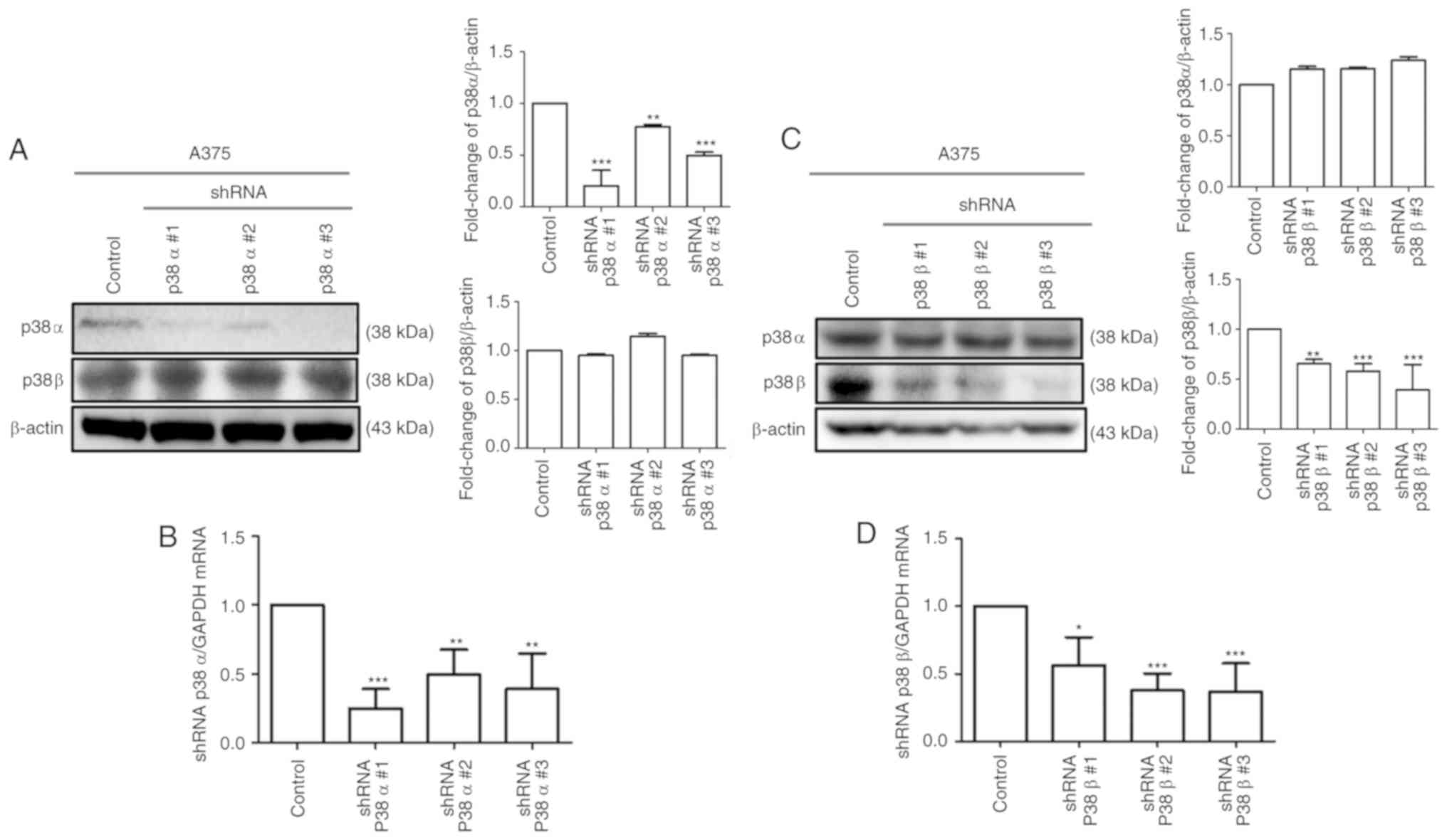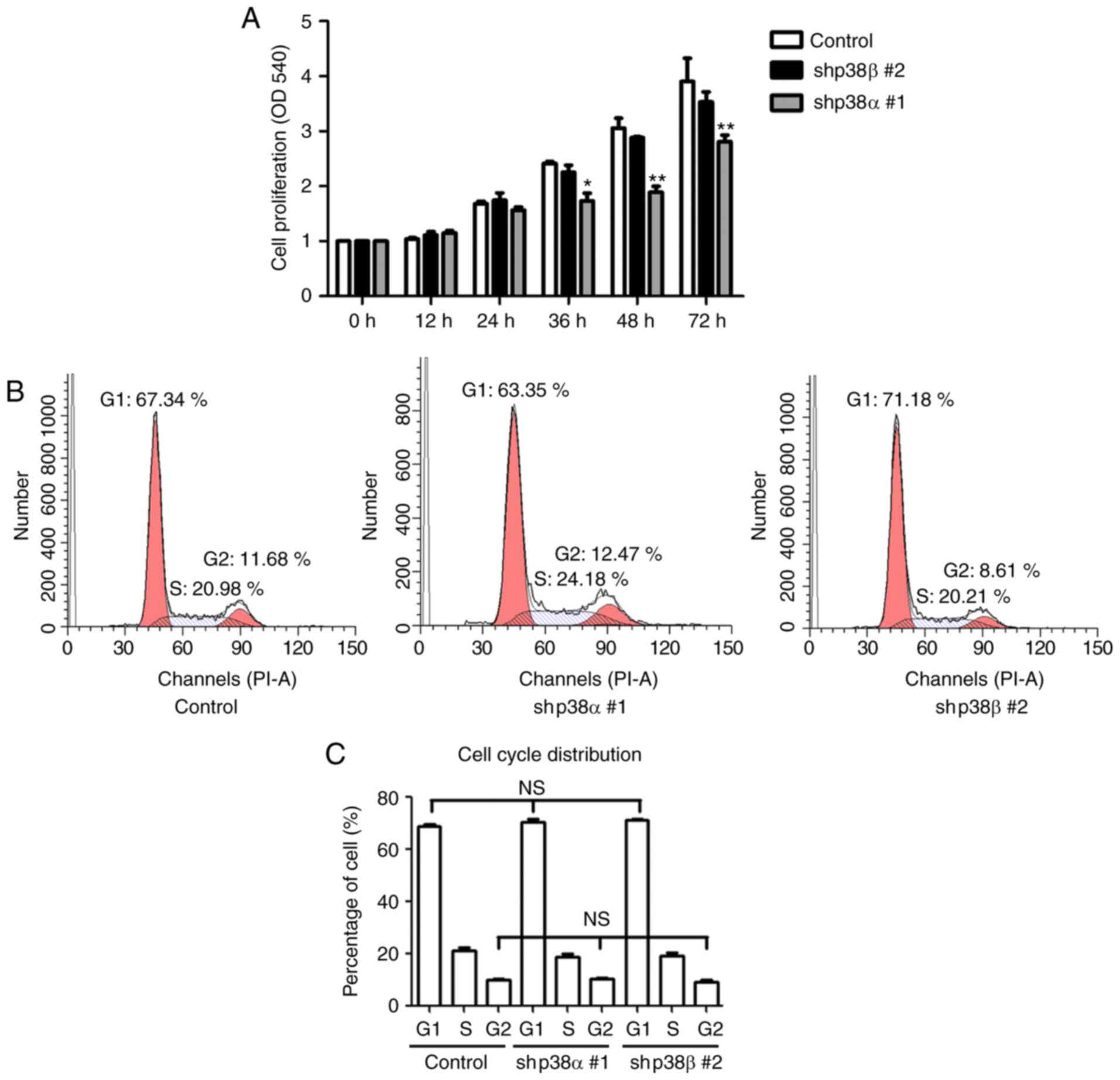|
1
|
Siegel RL, Miller KD and Jemal A: Cancer
statistics, 2017. CA Cancer J Clin. 67:7–30. 2017. View Article : Google Scholar : PubMed/NCBI
|
|
2
|
Fogel AL, Jaju PD, Li S, Halpern-Felsher
B, Tang JY and Sarin KY: Factors influencing and modifying the
decision to pursue genetic testing for skin cancer risk. J Am Acad
Dermatol. 76:829–835. 2017. View Article : Google Scholar : PubMed/NCBI
|
|
3
|
Bradford PT: Skin cancer in skin of color.
Dermatol Nurs. 21:170–177. 2009.PubMed/NCBI
|
|
4
|
Koul HK, Pal M and Koul S: Role of p38 MAP
kinase signal transduction in solid tumors. Genes Cancer.
4:342–359. 2013. View Article : Google Scholar : PubMed/NCBI
|
|
5
|
Cuenda A and Rousseau S: P38 MAP-kinases
pathway regulation, function and role in human diseases. Biochim
Biophys Acta. 1773:1358–1375. 2007. View Article : Google Scholar : PubMed/NCBI
|
|
6
|
Cuadrado A and Nebreda AR: Mechanisms and
functions of p38 MAPK signalling. Biochem J. 429:403–417. 2010.
View Article : Google Scholar : PubMed/NCBI
|
|
7
|
Patel SB, Cameron PM, O'Keefe SJ,
Frantz-Wattley B, Thompson J, O'Neill EA, Tennis T, Liu L, Becker
JW and Scapin G: The three-dimensional structure of MAP kinase
p38beta: Different features of the ATP-binding site in p38beta
compared with p38alpha. Acta Crystallogr D Biol Crystallogr.
65:777–785. 2009. View Article : Google Scholar : PubMed/NCBI
|
|
8
|
Katz M, Amit I and Yarden Y: Regulation of
MAPKs by growth factors and receptor tyrosine kinases. Biochim
Biophys Acta. 1773:1161–1176. 2007. View Article : Google Scholar : PubMed/NCBI
|
|
9
|
Bulavin DV and Fornace AJ Jr: P38 MAP
kinase's emerging role as a tumor suppressor. Adv Cancer Res.
92:95–118. 2004. View Article : Google Scholar : PubMed/NCBI
|
|
10
|
Igea A and Nebreda AR: The stress kinase
p38α as a target for cancer therapy. Cancer Res. 75:3997–4002.
2015. View Article : Google Scholar : PubMed/NCBI
|
|
11
|
Wagner EF and Nebreda AR: Signal
integration by JNK and p38 MAPK pathways in cancer development. Nat
Rev Cancer. 9:537–549. 2009. View
Article : Google Scholar : PubMed/NCBI
|
|
12
|
Gupta J, del Barco Barrantes I, Igea A,
Sakellariou S, Pateras IS, Gorgoulis VG and Nebreda AR: Dual
function of p38α MAPK in colon cancer: Suppression of
colitis-associated tumor initiation but requirement for cancer cell
survival. Cancer Cell. 25:484–500. 2014. View Article : Google Scholar : PubMed/NCBI
|
|
13
|
Chiacchiera F, Matrone A, Ferrari E,
Ingravallo G, Lo Sasso G, Murzilli S, Petruzzelli M, Salvatore L,
Moschetta A and Simone C: P38alpha blockade inhibits colorectal
cancer growth in vivo by inducing a switch from HIF1alpha- to
FoxO-dependent transcription. Cell Death Differ. 16:1203–1214.
2009. View Article : Google Scholar : PubMed/NCBI
|
|
14
|
Kalluri R and Weinberg RA: The basics of
epithelial-mesenchymal transition. J Clin Invest. 119:1420–1428.
2009. View
Article : Google Scholar : PubMed/NCBI
|
|
15
|
Kalluri R and Neilson EG:
Epithelial-mesenchymal transition and its implications for
fibrosis. J Clin Invest. 112:1776–1784. 2003. View Article : Google Scholar : PubMed/NCBI
|
|
16
|
Hay ED: An overview of
epithelio-mesenchymal transformation. Acta Anat (Basel). 154:8–20.
1995. View Article : Google Scholar
|
|
17
|
Lee JM, Dedhar S, Kalluri R and Thompson
EW: The epithelial-mesenchymal transition: New insights in
signaling, development, and disease. J Cell Biol. 172:973–981.
2006. View Article : Google Scholar : PubMed/NCBI
|
|
18
|
Zeisberg M and Neilson EG: Biomarkers for
epithelial-mesenchymal transitions. J Clin Invest. 119:1429–1437.
2009. View
Article : Google Scholar : PubMed/NCBI
|
|
19
|
Voutsadakis IA: The network of
pluripotency, epithelial-mesenchymal transition, and prognosis of
breast cancer. Breast Cancer (Dove Med Press). 7:303–319. 2015.
|
|
20
|
Liu CY, Lin HH, Tang MJ and Wang YK:
Vimentin contributes to epithelial-mesenchymal transition cancer
cell mechanics by mediating cytoskeletal organization and focal
adhesion maturation. Oncotarget. 6:15966–15983. 2015.PubMed/NCBI
|
|
21
|
Bauvois B: New facets of matrix
metalloproteinases MMP-2 and MMP-9 as cell surface transducers:
Outside-in signaling and relationship to tumor progression. Biochim
Biophys Acta. 1825:29–36. 2012.
|
|
22
|
Linnskog R, Jonsson G, Axelsson L, Prasad
CP and Andersson T: Interleukin-6 drives melanoma cell motility
through p38α-MAPK-dependent up-regulation of WNT5A expression. Mol
Oncol. 8:1365–1378. 2014. View Article : Google Scholar : PubMed/NCBI
|
|
23
|
Yan Q, Bach DQ, Gatla N, Sun P, Liu JW, Lu
JY, Paller AS and Wang XQ: Deacetylated GM3 promotes
uPAR-associated membrane molecular complex to activate p38 MAPK in
metastatic melanoma. Mol Cancer Res. 11:665–675. 2013. View Article : Google Scholar : PubMed/NCBI
|
|
24
|
del Barco Barrantes I and Nebreda AR:
Roles of p38 MAPKs in invasion and metastasis. Biochem Soc Trans.
40:79–84. 2012. View Article : Google Scholar : PubMed/NCBI
|
|
25
|
Lee WH, Liu FH, Lee YL and Huang HM:
Interferon-alpha induces the growth inhibition of human T-cell
leukaemia line jurkat through p38alpha and p38beta. J Biochem.
147:645–650. 2010. View Article : Google Scholar : PubMed/NCBI
|
|
26
|
Hale KK, Trollinger D, Rihanek M and
Manthey CL: Differential expression and activation of p38
mitogen-activated protein kinase alpha, beta, gamma, and delta in
inflammatory cell lineages. J Immunol. 162:4246–4252.
1999.PubMed/NCBI
|
|
27
|
Kuma Y, Campbell DG and Cuenda A:
Identification of glycogen synthase as a new substrate for
stress-activated protein kinase 2b/p38beta. Biochem J. 379:133–139.
2004. View Article : Google Scholar
|
|
28
|
Lee MR, Lin C, Lu CC, Kuo SC, Tsao JW,
Juan YN, Chiu HY, Lee FY, Yang JS and Tsai FJ: YC-1 induces G0/G1
phase arrest and mitochondria-dependent apoptosis in
cisplatin-resistant human oral cancer CAR cells. Biomedicine
(Taipei). 7:122017. View Article : Google Scholar
|
|
29
|
Su D, Zhu S, Han X, Feng Y, Huang H, Ren
G, Pan L, Zhang Y, Lu J and Huang B: BMP4-Smad signaling pathway
mediates adriamycin-induced premature senescence in lung cancer
cells. J Biol Chem. 284:12153–12164. 2009. View Article : Google Scholar : PubMed/NCBI
|
|
30
|
Piazza VG, Bartke A, Miquet JG and Sotelo
AI: Analysis of different approaches for the selection of reference
genes in RT-qPCR experiments: A case study in skeletal muscle of
growing mice. Int J Mol Sci. 18:E10602017. View Article : Google Scholar : PubMed/NCBI
|
|
31
|
Linnskog R, Mohapatra P, Moradi F, Prasad
CP and Andersson T: Demonstration of a WNT5A-IL-6 positive feedback
loop in melanoma cells: Dual interference of this loop more
effectively impairs melanoma cell invasion. Oncotarget.
7:37790–37802. 2016. View Article : Google Scholar : PubMed/NCBI
|
|
32
|
Liu K, Yu D, Cho YY, Bode AM, Ma W, Yao K,
Li S, Li J, Bowden GT and Dong Z and Dong Z: Sunlight UV-induced
skin cancer relies upon activation of the p38α signaling pathway.
Cancer Res. 73:2181–2188. 2013. View Article : Google Scholar : PubMed/NCBI
|
|
33
|
Liu H, He J and Yang J: Tumor cell p38
MAPK: A trigger of cancer bone osteolysis. Cancer Cell
Microenviron. 2:e4642015.PubMed/NCBI
|
|
34
|
Gonzalez-Villasana V, Fuentes-Mattei E,
Ivan C, Dalton HJ, Rodriguez-Aguayo C, Fernandez-de Thomas RJ,
Aslan B, Del C, Monroig P, Velazquez-Torres G, Previs RA, et al:
Rac1/Pak1/p38/MMP-2 axis regulates angiogenesis in ovarian cancer.
Clin Cancer Res. 21:2127–2137. 2015. View Article : Google Scholar : PubMed/NCBI
|
|
35
|
Loesch M and Chen G: The p38 MAPK stress
pathway as a tumor suppressor or more? Front Biosci. 13:3581–3593.
2008. View Article : Google Scholar : PubMed/NCBI
|
|
36
|
Ding XZ and Adrian TE: MEK/ERK-mediated
proliferation is negatively regulated by P38 map kinase in the
human pancreatic cancer cell line, PANC-1. Biochem Biophys Res
Commun. 282:447–453. 2001. View Article : Google Scholar : PubMed/NCBI
|
|
37
|
Cocolakis E, Lemay S, Ali S and Lebrun JJ:
The p38 MAPK pathway is required for cell growth inhibition of
human breast cancer cells in response to activin. J Biol Chem.
276:18430–18436. 2001. View Article : Google Scholar : PubMed/NCBI
|
|
38
|
Grossi V, Peserico A, Tezil T and Simone
C: p38α MAPK pathway: A key factor in colorectal cancer therapy and
chemoresistance. World J Gastroenterol. 20:9744–9758. 2014.
View Article : Google Scholar : PubMed/NCBI
|
|
39
|
Tai TW, Su FC, Chen CY, Jou IM and Lin CF:
Activation of p38 MAPK-regulated Bcl-xL signaling increases
survival against zoledronic acid-induced apoptosis in osteoclast
precursors. Bone. 67:166–174. 2014. View Article : Google Scholar : PubMed/NCBI
|
|
40
|
Dreissigacker U, Mueller MS, Unger M,
Siegert P, Genze F, Gierschik P and Giehl K: Oncogenic K-Ras
down-regulates Rac1 and RhoA activity and enhances migration and
invasion of pancreatic carcinoma cells through activation of p38.
Cell Signal. 18:1156–1168. 2006. View Article : Google Scholar
|
|
41
|
Thiery JP and Sleeman JP: Complex networks
orchestrate epithelial-mesenchymal transitions. Nat Rev Mol Cell
Biol. 7:131–142. 2006. View Article : Google Scholar : PubMed/NCBI
|
|
42
|
Nakamura M and Tokura Y:
Epithelial-mesenchymal transition in the skin. J Dermatol Sci.
61:7–13. 2011. View Article : Google Scholar
|
|
43
|
Campbell RM, Anderson BD, Brooks NA,
Brooks HB, Chan EM, De Dios A, Gilmour R, Graff JR, Jambrina E,
Mader M, et al: Characterization of LY2228820 dimesylate, a potent
and selective inhibitor of p38 MAPK with antitumor activity. Mol
Cancer Ther. 13:364–374. 2014. View Article : Google Scholar
|
|
44
|
Pereira L, Igea A, Canovas B, Dolado I and
Nebreda AR: Inhibition of p38 MAPK sensitizes tumour cells to
cisplatin-induced apoptosis mediated by reactive oxygen species and
JNK. EMBO Mol Med. 5:1759–1774. 2013. View Article : Google Scholar : PubMed/NCBI
|
|
45
|
Ventura JJ, Tenbaum S, Perdiguero E, Huth
M, Guerra C, Barbacid M, Pasparakis M and Nebreda AR: p38alpha MAP
kinase is essential in lung stem and progenitor cell proliferation
and differentiation. Nat Genet. 39:750–758. 2007. View Article : Google Scholar : PubMed/NCBI
|
|
46
|
Hui L, Bakiri L, Mairhorfer A, Schweifer
N, Haslinger C, Kenner L, Komnenovic V, Scheuch H, Beug H and
Wagner EF: p38alpha suppresses normal and cancer cell proliferation
by antagonizing the JNK-c-Jun pathway. Nat Genet. 39:741–749. 2007.
View Article : Google Scholar : PubMed/NCBI
|
|
47
|
Sakurai T, He G, Matsuzawa A, Yu GY, Maeda
S, Hardiman G and Karin M: Hepatocyte necrosis induced by oxidative
stress and IL-1 alpha release mediate carcinogen-induced
compensatory proliferation and liver tumorigenesis. Cancer Cell.
14:156–165. 2008. View Article : Google Scholar : PubMed/NCBI
|
|
48
|
Rajabi M and Mousa SA: The role of
angiogenesis in cancer treatment. Biomedicines. 5:E342017.
View Article : Google Scholar : PubMed/NCBI
|
|
49
|
Mehrad B, Keane MP and Strieter RM:
Chemokines as mediators of angiogenesis. Thromb Haemost.
97:755–762. 2007. View Article : Google Scholar : PubMed/NCBI
|
|
50
|
Yoshizuka N, Chen RM, Xu Z, Liao R, Hong
L, Hu WY, Yu G, Han J, Chen L and Sun P: A novel function of
p38-regulated/activated kinase in endothelial cell migration and
tumor angiogenesis. Mol Cell Biol. 32:606–618. 2012. View Article : Google Scholar :
|
|
51
|
Fouad YA and Aanei C: Revisiting the
hallmarks of cancer. Am J Cancer Res. 7:1016–1036. 2017.PubMed/NCBI
|
|
52
|
Cairney CJ, Bilsland AE, Evans TR, Roffey
J, Bennett DC, Narita M, Torrance CJ and Keith WN: Cancer cell
senescence: A new frontier in drug development. Drug Discov Today.
17:269–276. 2012. View Article : Google Scholar : PubMed/NCBI
|
|
53
|
Prieur A and Peeper DS: Cellular
senescence in vivo: A barrier to tumorigenesis. Curr Opin Cell
Biol. 20:150–155. 2008. View Article : Google Scholar : PubMed/NCBI
|
|
54
|
Bai M, Yu NZ, Long F, Feng C and Wang XJ:
Effects of CDKN2A (p16INK4A/p14ARF) over-expression on
proliferation and migration of human melanoma A375 Cells. Cell
Physiol Biochem. 40:1367–1376. 2016. View Article : Google Scholar : PubMed/NCBI
|














